Table of contents
- Finale: The history of the Sachsenring Sachsenring: The mountain and valley railway
- The history of the Sachsenring
- Mountain and valley railway
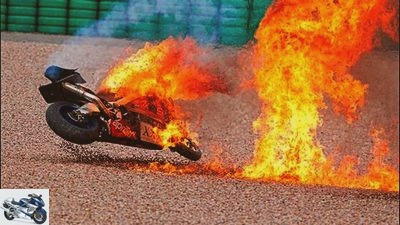
2Snap
Sports & scene
Motorsport
Motorcycle racing track: the history of the Sachsenring
Finale: The history of the Sachsenring
Sachsenring: The mountain and valley railway
Brilliant triumphs, sad tragedies: The Sachsenring, with its history dating back to the 1920s, has seen it all. A review. At the end of 2011 we can look forward to the extension for the German GP.
Michael Schumann
07/07/2011
The history of the Sachsenring
Once again it was the fault of the weather. In this case the chronically bad part of the Eifel. The frequent rain and the cold and wet climate were blamed by the ADAC, as the organizer of the German Grand Prix, for the fact that the public’s interest in the motorcycle world championship at the Nurburgring in the 1990s was increasingly dramatic. After the 1997 GP in front of just 20,000 undaunted people in yawning empty stands, the news finally came that the World Cup in Germany would be moving. Namely to the Sachsenring, which celebrated its 60th anniversary in the same year.
Buy complete article
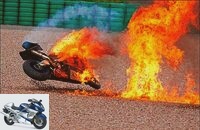
Finale: The history of the Sachsenring
Sachsenring: The mountain and valley railway
4 pages) as PDF
€ 2.00
Buy now
The route had a long tradition, but was brand new – thanks to Aufbau Ost. The new Sachsenring, which for political and tactical reasons was initially conceived as a traffic safety center, had nothing to do with the 8.6-kilometer circuit, which had been running on normal roads since 1927, partly through the urban area of Hohenstein-Ernstthal and partly through forest. But we’ll get to that later. Because it’s worth taking a look at the long history of the route beforehand. It lets you understand why the enthusiasm for motorcycling seems to be so much more pronounced in Saxony than in the rest of the republic. This enthusiasm is also closely related to MZ, whose factory premises are just 30 kilometers away from the Sachsenring. Because MZ was a kind of national shrine for Saxony in GDR times. For the people, the success of the brand was proof that they could take on the rich class enemy in the West. And MZ had been a constant in racing since the 1950s: In 1958, Horst Fugner from Chemnitz became vice world champion in the 250cc class on MZ, which Rhodesian Gary Hocking repeated in 1959. The Saxons finally celebrated their greatest home triumph in 1963, when Mike Hailwood and Alan Shepherd gave away a double victory at the Sachsenring MZ, ahead of Jim Redman on Honda and the Hungarian Laszlo Szabo on another MZ. The 100,000 spectators were so excited that the winner’s lap of honor lasted almost an hour before the cheers subsided.
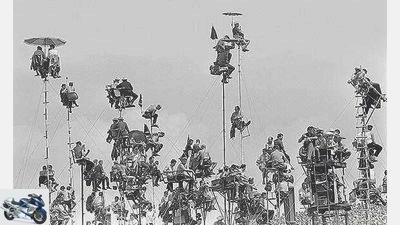
Woolett
Brave fans defy gravity to get the best view of the track.
Until 1972, enthusiastic GDR citizens were allowed to smell not only the familiar scent of two-stroke engines, but also that of the big wide world every year at the Sachsenring. With Jim Redman, Mike Hailwood, Phil Read, Giacomo Agostini and the young Barry Sheene, international stars were regularly at the start. And with Dieter Braun’s victory in 1971, the triumph of a compatriot could again be celebrated. However, and that was a thorn in the side of the political leadership, it came from the West. But forbid the no less than 250,000 raging fans to celebrate the winner? That went badly.
So those responsible resorted to other means: Because he had crossed a white sideline in the race, Braun should be disqualified afterwards. Only the Belgian World Cup boss and the local race director knew the international sports regulations and refused to carry out the absurd instructions from officials. Which ultimately led to the fact that during the award ceremony the power for the loudspeaker system went out at the exact moment when the West German national anthem was supposed to sound for Braun. Probably in order to avoid further weaknesses of this kind, the GDR leadership canceled the 1973 motorcycle world championship completely, which meant the end of the old Sachsenring as an international race track.
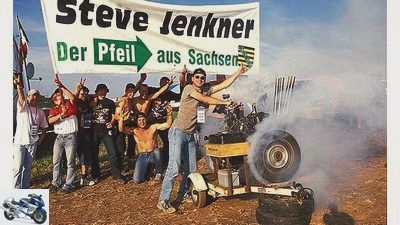
wolf
On the race weekends, the punk is going on on the Ankerberg, which is used as a campground, opposite the track. Ex-favorite Steve Jenkner lives only one kilometer away.
The new one was baptized by fire 25 years later: In 1998, when the Australian Mick Doohan was on his way to the last of his five world championship titles in the 500cc class, the motorcycle world championship returned to Hohenstein-Ernstthal. The new Sachsenring no longer has anything to do with the old “natural race track”, which ran frighteningly close to trees, lamp posts and garden fences. Nevertheless, the drivers were very skeptical at the beginning. There was talk of a “Mickey Mouse course”. Above all, Doohan blasphemed, called the track too narrow, too slow, with too many curves, inclines and declines, at best suitable as a go-kart track. Rival Max Biaggi countered that you had to be able to drive on the Sachsenring. “Whoever wins here is Superman,” said the Italian. After 31 rounds, the honor went to Doohan. After all, Biaggi came second.
On July 17, 2011, the 13th World Championship run since the reopening in 1998 will take place at the Sachsenring. And as in the past, Germans have serious chances to win again: Jonas Folger (125cc) and Stefan Bradl (Moto2) are hot favorites. But no matter what happens, the loudspeaker system will work.
Mountain and valley railway
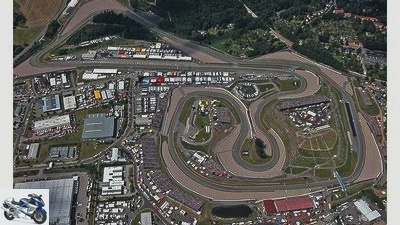
2Snap
The Sachsenring from above. At around 3.7 km in length, the Sachsenring Grand Prix circuit is the shortest of the 2011 MotoGP season.
The Sachsenring is as spectacular as what happens on it during the major motorcycle races. No other racetrack offers so many steep inclines and descents over a mere 3.7 km. Start free for a round of the ring in words:
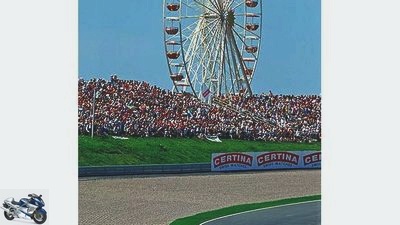
fact
In 1998 the World Cup came back to the modern Sachsenring after a break of 25 years. Not without resistance.
The start / finish straight runs parallel to a hill ridge. In front of it, behind it, left and right of it go downwards. This is still moderate in the narrow right after the straight, but if you jiggle to the left for the following curve, you think you’re jumping over an edge in free fall down into the valley. Stay outside for a long time before changing the lean angle, because the right-hand entrance of the Omega is tightening a bit. The same strategy also puts you on the fastest line at the exit. Here it is already going uphill again. Accelerating fully, the lean angle is changed again quickly and not too early for the longest left-hand bend in the world, a six-in-one bend, so to speak. In a full incline it goes over the top, behind it the best drivers in the world speed down to the valley again at full speed. Terrifying bumps in the downhill left in front of the kart hall and the curve radius make it necessary to take the gas off, the pace remains insanely high. Then the route leads upwards again in a left-leaning position. This is much faster than it initially seems possible, the visual impression is deceptive here. Before the next left bend you cannot see the right edge of the track because of an edge. Optimizing cornering speed takes a lot of courage or practice or both. This also applies in a more stringent way to the passage after the longest left-hand bend. For a short distance you are back at the height of the start / finish, now full throttle for a short time and downhill to the right at full speed. Whoever turns here does not have to be a coward, because the turning point – again a sharp change of lean angle is necessary – you have to hit exactly in order not to land off the track. The following Saxon curve also closes. For the fastest line you stay outside for a long time, but then run the risk of being slowed down on the inside line. But it is not uncommon for those who want to slow down here at the exit to be tight. Queckenberg curve – the name already suggests how the lap comes to an end: steeply uphill and full throttle again. Because of the inevitable wheelies, it is usually even steeper than the route actually is. Goal – time to wipe the sweat from your forehead.
Related articles
-
Film Racing Together History of the motorcycle world championship
Dorna Sports & scene Motorsport Film Racing Together History of the motorcycle world championship “Racing Together” on DVD and Blu-ray History of the…
-
NSU / Audi 11 pictures simplicissimus.info 1/11 The history of the motorcycle began around 1900. BMW 2/11 In the deepest valley of the motorcycle…
-
Motorcycle racing in New Zealand Horst Saiger
Saiger / Doug Cornes 20th pictures Saiger / Doug Cornes 1/20 Horst Saiger accepted the official invitation to the Suzuki series, … Saiger / Doug Cornes…
-
Fathers and sons in motorcycle racing
2snap 13th pictures 2snap 1/13 Peter Ottl already supported his son Philipp in the Red Bull Rookies Cup. 2snap 2/13 In 2016, Philipp Ottl experienced his…
-
Legendary riders from motorcycle racing
ADAC 14th pictures archive 1/14 Start of the German Grand Prix in Hockenheim 1985 in front of full ranks. archive 2/14 The most famous black line in the…
-
Schwab Sports & scene History of motorcycle tuning History of motorcycle tuning Tuners have never had it harder Content of About 50 years ago, motorcycle…
-
Motorcycle racing on the ski slope
r-photography.info 19th pictures Rossen Gargolov 1/19 The Snow Speed Hill is floodlit fun. Rossen Gargolov 2/19 Impressions from Snow Speed Hill in…
-
IDM at the Sachsenring: on Monday and Tuesday (September 7th and 8th)
Dino Eisele Sports & scene Motorsport IDM at the Sachsenring: on Monday and Tuesday (September 7th and 8th) IDM on Monday and Tuesday (September 7th and…
-
racepixx 13th pictures Racepixx.de 1/13 KTM Duke Battle Sachsenring 2013 Racepixx.de 2/13 KTM Duke Battle Sachsenring 2013 Racepixx.de 3/13 KTM Duke…
-
Extreme lean angles in motorcycle racing
2Snap 13th pictures Gori 1/13 Lie down in the curves… fact 2/13 …is probably the greatest passion of motorcyclists. fact 3/13 A good incline needs to…